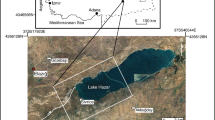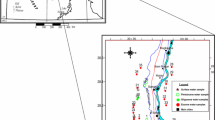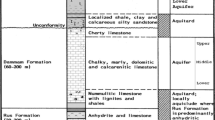Abstract
The hydrogeochemistry and isotope geochemistry of groundwater from 85 wells in fractured dolomite aquifers of Central Slovenia were investigated. This groundwater represents waters strongly influenced by chemical weathering of dolomite with an average of δ13CCARB value of +2.2 ‰. The major groundwater geochemical composition is HCO3 − > Ca2+ > Mg2+. Several differences in hydrogeochemical properties among the classes of dolomites were observed when they were divided based on their age and sedimentological properties, with a clear distinction of pure dolomites exhibiting high Mg2+/Ca2+ ratios and low Na+, K+ and Si values. Trace element and nutrient concentrations (SO4 2−, NO3 −) were low, implying that karstic and fractured dolomite aquifers are of good quality to be used as tap water. Groundwater was generally slightly oversaturated with respect to calcite and dolomite, and dissolved CO2 was up to 46 times supersaturated relative to the atmosphere. The isotopic composition of oxygen (δ18OH2O), hydrogen (δDH2O) and tritium ranged from −10.3 to −8.4 ‰, from −68.5 to −52.7 ‰ and from 3.5 TU to 10.5 TU, respectively. δ18O and δD values fell between the GMWL (Global Meteoric Water Line) and the MMWL (Mediterranean Meteoric Water Line) and indicate recharge from precipitation with little evaporation. The tritium activity in groundwater suggests that groundwater is generally younger than 50 years. δ13CDIC values ranged from −14.6 to −9.3 ‰ and indicated groundwater with a contribution of degraded organic matter/dissolved inorganic carbon in the aquifer. The mass balances for groundwater interacting with carbonate rocks suggested that carbonate dissolution contributes from 43.7 to 65.4 % and degradation of organic matter from 34.6 to 56.3 %.









Similar content being viewed by others
References
Aguilera R (1980) Naturally fractured reservoirs. PennWell Books, Tulsa
Appelo CAJ, Postma D (2005) Geochemistry, groundwater and pollution, 2nd edn. Balkema, Leiden
ARSO (Agencija Republike Slovenije za Okolje = Slovenian Environment Agency) (2006) Podnebne razmere v Sloveniji (obdobje 1971–2000) = Climate conditions in Slovenia (period 1971–2000). Ljubljana. http://meteo.arso.gov.si/uploads/probase/www/climate/text/sl/publications/podnebne_razmere_v_sloveniji_71_00.pdf. (In Slovene)
Atekwana EA, Krishnamurthy RV (1998) Seasonal variations of dissolved inorganic carbon and δ13C of surface waters: application of a modified gas evolution technique. J Hydrol 205:265–278. doi:10.1016/s0022-1694(98)00080-8
Böttcher J, Strebel O, Voerkelius S, Schmidt HL (1990) Using isotope fractionation of nitrate-nitrogen and nitrate-oxygen for evaluation of microbial denitrification in a sandy aquifer. J Hydrol 114:413–424. doi:10.1016/0022-1694(90)90068-9
Buser S (1987) Geological map of Slovenia. In: Voglar D (ed) Encyclopedia of Slovenia No. 8. Mladinska knjiga, Ljubljana
Buser S (1989) Development of the Dinaric and the Julian carbonate platforms and of the intermediate Slovenian basin (NW Yugoslavia). Mem Soc Geol Ital 40:313–320
Cartwright I, Weaver T, Tweed S, Ahearne D, Cooper M, Czapnik C, Tranter J (2000) O, H, C isotope geochemistry of carbonated mineral springs in central Victoria, Australia: sources of gas and water–rock interaction during dying basaltic volcanism. J Geochem Explor 69–70:257–261. doi:10.1016/s0375-6742(00)00059-5
Cartwright I, Weaver TR, Cendón DI, Fifield LK, Tweed SO, Petrides B, Swane I (2012) Constraining groundwater flow, residence times, inter-aquifer mixing, and aquifer properties using environmental isotopes in the southeast Murray Basin. Aust Appl Geochem 27:1698–1709. doi:10.1016/j.apgeochem.2012.02.006
Clark ID, Fritz P (1997) Environmental isotopes in hydrogeology. CRC Press/Lewis Publishers, Boca Raton
Clesceri LS, Greenberg AE, Eaton AD (1998) Standard methods for the examination of water and wastewater, 20th edn. APHA, AWWA, WEF, Baltimore
Cook PG, Herczeg AL (2000) Environmental tracers in subsurface hydrology. Kluwer Academic Publishers, Boston. doi:10.1007/978-1-4615-4557-6
Craig H (1961) Isotopic variations in meteoric waters science 133:1702–1703. doi:10.1126/science.133.3465.1702
Croghan CW, Egeghy PP (2003) Methods of dealing with values below the limit of detection using SAS. In: Paper presented at the Southeastern SAS User Group, St. Petersburg, FL, USA, 22–24 Sept 2003
Daniele L, Vallejos Á, Corbella M, Molina L, Pulido-Bosch A (2013) Hydrogeochemistry and geochemical simulations to assess water-rock interactions in complex carbonate aquifers: the case of Aguadulce (SE Spain). Appl Geochem 29:43–54
Dansgaard W (1964) Stable isotopes in precipitation. Tellus 16:436–468. doi:10.1111/j.2153-3490.1964.tb00181.x
Deines P, Langmuir D, Harmon RS (1974) Stable carbon isotope ratios and the existence of a gas phase in the evolution of carbonate ground waters. Geochim Cosmochim Acta 38:1147–1164. doi:10.1016/0016-7037(74)90010-6
Drever JI (1988) The geochemistry of natural waters, 2nd edn. Prentice Hall, Englewood Cliffs
Drew D, Hötzl H (1999) Karst hydrogeology and human activities : impacts, consequences, and implications. International contributions to hydrogeology, vol 20. A.A. Balkema, Rotterdam; Brookfield, VT
Edmunds WM (2009) Geochemistry’s vital contribution to solving water resource problems. Appl Geochem 24:1058–1073. doi:10.1016/j.apgeochem.2009.02.021
Epstein S, Mayeda T (1953) Variation of O18 content of waters from natural sources. Geochim Cosmochim Acta 4:213–224. doi:10.1016/0016-7037(53)90051-9
Fairchild IJ, Tuckwell GW, Baker A, Tooth AF (2006) Modelling of dripwater hydrology and hydrogeochemistry in a weakly karstified aquifer (Bath, UK): implications for climate changes studies. J Hydrol 321:213–231
Ford D, Williams PW (2007) Karst hydrogeology and geomorphology, Rev. edn. Wiley, Chichester
Frisia S (1994) Mechanisms of complete dolomitization in a carbonate shelf: comparison between the Norian Dolomia Principale (Italy) and the Holocene of Abu Dhabi Sabkha, 2nd edn. Blackwell Publishing Ltd., Dolomites, pp 55–74. doi:10.1002/9781444304077.ch5
Fritz P, Fontes JC (1980) Handbook of environmental isotope geochemistry, the terrestrial environment, A vol A. Elsevier, Amsterdam
Fry B, Ruf W, Gest H, Hayes JM (1988) Sulfur isotope effects associated with oxidation of sulfide by O2 in aqueous solution. Chem Geol Isot Geosc Sect 73:205–210. doi:10.1016/0168-9622(88)90001-2
Galloway JN, Schlesinger WH, Levy H, Michaels A, Schnoor JL (1995) Nitrogen fixation: anthropogenic enhancement-environmental response. Global Biogeochem Cycle 9:235–252. doi:10.1029/95gb00158
Glass DC, Gray CN (2001) Estimating mean exposures from censored data: exposure to benzene in the Australian petroleum industry. Ann Occup Hyg 45:275–282
Gröning M, Rozanski K (2003) Uncertainty assessment of environmental tritium measurements in water. Accred Qual Assur 8:359–366. doi:10.1007/s00769-003-0631-y
Haas J, Budai T (1999) Triassic sequence stratigraphy of the transdanubian range (Hungary). Geol Carpath 50:459–475
Hem JD (1985) Study and interpretation of the chemical characteristics of natural water. US Geological Survey water-supply paper WSP2254, vol 2254, 3rd edn. USGS, Reston, VA
Herman JS, Lorah MM (1987) CO2 outgassing and calcite precipitation in Falling Spring Creek, Virginia, U.S.A. Chem Geol 62:251–262. doi:10.1016/0009-2541(87)90090-8
IAEA (2005) Isotopic composition of precipitation in the Mediterranean Basin in relation to air circulation patterns and climate. Final report of coordinated research project 2000–2004. IAEA, Austria
Kanduč T (2006) Hydrogeochemical characteristics and carbon cycling in the Sava River watershed in Slovenia = Hidrogeokemične značilnosti in kroženje ogljika v porečju reke Save v Sloveniji. University of Ljubljana, Faculty of Natural Sciences and Engineering
Kanduč T, Ogrinc N, Mrak T (2007a) Characteristics of suspended matter in the River Sava watershed, Slovenia. Isot Environ Health Stud 43:369–386. doi:10.1080/10256010701705112
Kanduč T, Szramek K, Ogrinc N, Walter LM (2007b) Origin and cycling of riverine inorganic carbon in the Sava River watershed (Slovenia) inferred from major solutes and stable carbon isotopes. Biogeochemistry 86:137–154. doi:10.1007/s10533-007-9149-4
Kanduč T, Mori N, Kocman D, Stibilj V, Grassa F (2012) Hydrogeochemistry of Alpine springs from North Slovenia: insights from stable isotopes. Chem Geol 300–301:40–54. doi:10.1016/j.chemgeo.2012.01.012
Kanduč T, Šturm MB, McIntosh J (2013) Chemical dynamics and evaluation of biogeochemical processes in alpine River Kamniška Bistrica, North Slovenia. Aquat Geochem 19:323–346. doi:10.1007/s10498-013-9197-4
Kanduč T, Grassa F, McIntosh J, Stibilj V, Ulrich-Supovec M, Supovec I, Jamnikar S (2014) A geochemical and stable isotope investigation of groundwater/surface-water interactions in the Velenje Basin. Hydrogeol J, Slovenia. doi:10.1007/s10040-014-1103-7
Katz BG, Coplen TB, Bullen TD, Davis JH (1997) Use of chemical and isotopic tracers to characterize the interactions between ground water and surface water in mantled karst. Ground Water 35:1014–1028. doi:10.1111/j.1745-6584.1997.tb00174.x
Kendall C, Sklash MG, Bullen TD (1995) Isotope tracers of water and solute sources in catchments. In: Trudgill ST (ed) Solute modelling in catchment system. Wiley, New York, pp 261–303
Kennedy VC, Kendall C, Zellweger GW, Wyerman TA, Avanzino RJ (1986) Determination of the components of stormflow using water chemistry and environmental isotopes, Mattole River basin, California. J Hydrol 84:107–140. doi:10.1016/0022-1694(86)90047-8
Klass DL (1984) Methane from anaerobic fermentation. Science 223:1021–1028. doi:10.1126/science.223.4640.1021
Koceli A, Kanduč T, Verbovšek T (2013) Inorganic carbon cycle in soil-rock-groundwater system in karst and fissured aquifers. Geologija 56:219–228. doi:10.5474/geologija.2013.014
Larsen D, Swihart GH, Xiao Y (2001) Hydrochemistry and isotope composition of springs in the Tecopa basin, southeastern California, USA. Chem Geol 179:17–35. doi:10.1016/s0009-2541(01)00313-8
Lesniak PM, Sakai H (1989) Carbon isotope fractionation between dissolved carbonate (CO32−) and CO2(g) at 25° and 40 °C. Earth Planet Sci Lett 95:297–301. doi:10.1016/0012-821x(89)90104-0
Ma R, Wang W, Sun Z, Zheng C, Ma T, Prommer H (2011) Geochemical evolution of groundwater in carbonate aquifers in Taiyuan, northern China. Appl Geochem 26:884–897
Machel HG, Krouse HR, Sassen R (1995) Products and distinguishing criteria of bacterial and thermochemical sulfate reduction. Appl Geochem 10:373–389. doi:10.1016/0883-2927(95)00008-8
Mandl GW (2000) The Alpine sector of the Tethyan shelf—Examples of Triassic to Jurassic sedimentation and deformation from the Northern Calcareous Alps. Mitteilungen der Österreichischen Geologischen Gesellschaft 92:61–77
Mayo AL, Loucks MD (1995) Solute and isotopic geochemistry and ground water flow in the central wasatch range, Utah. J Hydrol 172:31–59. doi:10.1016/0022-1694(95)02748-e
McIntosh JC, Martini AM (2008) Hydrogeochemical indicators for microbial methane in fractured black shales: case studies of the Antrim, New Albany, and Ohio shales. In: Hill D, P. L, J. C (eds) Gas Shale in the rocky mountains and beyond. pp 162–174
Miyajima T, Yamada Y, Hanba YT, Yoshii K, Koitabashi T, Wada E (1995) Determining the stable isotope ratio of total dissolved inorganic carbon in lake water by GC/C/IIRMS. Limnol Oceanogr 40:994–1000. doi:10.4319/lo.1995.40.5.0994
Mook WG, Bommerson JC, Staverman WH (1974) Carbon isotope fractionation between dissolved bicarbonate and gaseous carbon dioxide. Earth Planet Sci Lett 22:169–176. doi:10.1016/0012-821x(74)90078-8
Neuman SP (2005) Trends, prospects and challenges in quantifying flow and transport through fractured rocks. Hydrogeol J 13:124–147. doi:10.1007/s10040-004-0397-2
Ogorelec B (2011) Mikrofacies mezozojskih karbonatnih kamnin Slovenije = Microfacies of Mesozoic Carbonate Rocks of Slovenia. Geologija, vol 54/2. Geološki zavod Slovenije, Ljubljana. doi:10.5474/geologija.2011.011
Ogrin N (1998) Climate. In: Fridl J, Kladnik D, M. OA, Perko D (eds) Geographical Atlas. Državna Založba Slovenije, Ljubljana, Slovenia, pp 110–111
O’Leary MH (1988) Carbon isotopes in photosynthesis. Bioscience 38:328–336. doi:10.2307/1310735
Ozyurt NN, Lutz HO, Hunjak T, Mance D, Roller-Lutz Z (2014) Characterization of the Gacka River basin karst aquifer (Croatia): hydrogeochemistry, stable isotopes and tritium-based mean residence times. Sci Total Environ 487:245–254
Parkhurst DL (1995) User’s guide to PHREEQC—a computer program for speciation, reaction-path, advective-transport, and inverse geochemical calculations water-resources investigations report 95-4227
Petrič M (2004) Alpine Karst Waters In Slovenia = Vode Alpskega krasa v Sloveniji. Acta Carsol 33:11–24
Pezdič J (2003) Isotope fractionation of long term precipitation averages in Ljubljana. RMZ-Mater Geoenviron 50:643–652
Plastino W et al (2007) Tritium in water electrolytic enrichment and liquid scintillation counting. Radiat Meas 42:68–73. doi:10.1016/j.radmeas.2006.07.010
Purser BH, Brown A, Aissaoui DM (1994) Nature, origins and evolution of porosity in Dolomites. Dolomites, Blackwell Publishing Ltd, pp 281–308 doi:10.1002/9781444304077.ch16
Romanek CS, Grossman EL, Morse JW (1992) Carbon isotopic fractionation in synthetic aragonite and calcite: effects of temperature and precipitation rate. Geochim Cosmochim Ac 56:419–430. doi:10.1016/0016-7037(92)90142-6
Sakai H (1968) Isotopic properties of sulfur compounds in hydrothermal processes. Geochem J 2:29–49
Samborska K, Halas S, Bottrell SH (2013) Sources and impact of sulphate on groundwater of Triassic carbonate aquifers, Upper Silesia, Poland. J Hydrol 486:136–150
Spötl C (2005) A robust and fast method of sampling and analysis of δ13C of dissolved inorganic carbon in ground waters. Isot Environ Healt S 41:217–221. doi:10.1080/10256010500230023
Stearns DW, Friedman N (1972) Reservoirs in Fractured Rock. In: Gould HR (ed) AAPG Memoir 16: stratigraphic oil and gas fields—classification, exploration methods, and case histories, vol M 16. American Association of Petroleum Geologists (AAPG), pp 82–106
Succop PA, Clark S, Chen M, Galke W (2004) Imputation of data values that are less than a detection limit. J Occup Environ Hyg 1:436–441. doi:10.1080/15459620490462797
Szramek K, McIntosh JC, Williams EL, Kanduc T, Ogrinc N, Walter LM (2007) Relative weathering intensity of calcite versus dolomite in carbonate-bearing temperate zone watersheds: carbonate geochemistry and fluxes from catchments within the St. Lawrence and Danube river basins. Geochem Geophys Geosyst. doi:10.1029/2006gc001337
Szramek K, Walter LM, Kanduc T, Ogrinc N (2011) Dolomite Versus Calcite Weathering in Hydrogeochemically Diverse Watersheds Established on Bedded Carbonates (Sava and Soa Rivers, Slovenia). Aquat Geochem 17:357–396. doi:10.1007/s10498-011-9125-4
Taylor CB, Brown LJ, Cunliffe JJ, Davidson PW (1992) Environmental tritium and 18O applied in a hydrological study of the Wairau Plain and its contributing mountain catchments, Marlborough, New Zealand. J Hydrol 138:269–319. doi:10.1016/0022-1694(92)90168-u
Tillman FD, Oki DS, Johnson AG, Barber LB, Beisner KR (2014) Investigation of geochemical indicators to evaluate the connection between inland and coastal groundwater systems near Kaloko-Honokōhau National Historical Park, Hawai‘i. App Geochem 51:278–292. doi:10.1016/j.apgeochem.2014.10.003
Verbovšek T (2008a) Diagenetic effects on the well yield of dolomite aquifers in Slovenia. Environ Geol 53:1173–1182. doi:10.1007/s00254-007-0707-9
Verbovšek T (2008b) Estimation of transmissivity and hydraulic conductivity from specific capacity and specific capacity index in dolomite aquifers. J Hydrol Eng 13:817–823. doi:10.1061/(Asce)1084-0699(2008)13:9(817)
Verbovšek T (2008c) Hydraulic conductivities of fractures and matrix in Slovenian carbonate aquifers. Geologija 51:245–255. doi:10.5474/geologija.2008.025
Verbovšek T (2009) Influences of aquifer properties on flow dimensions in dolomites. Ground Water 47:660–668. doi:10.1111/j.1745-6584.2009.00577.x
Verbovšek T (2011) A comparison of parameters below the limit of detection in geochemical analyses by substitution methods = Primerjava ocenitev parametrov pod mejo določljivosti pri geokemičnih analizah z metodo nadomeščanja RMZ - Materials and Geoenvironment 58:393–404
Verbovšek T (2012) Ca and Mg in fractured and karstic aquifers of Slovenia. V: International seminar calcium and magnesium in groundwater: distribution and significance, Katowice, Poland, 27-29th Paper presented at the International Seminar Calcium and Magnesium in Groundwater: Distribution and Significance, Katowice, Poland, 27–29th September 2012
Verbovšek T, Veselič M (2008) Factors influencing the hydraulic properties of wells in dolomite aquifers of Slovenia. Hydrogeol J 16:779–795. doi:10.1007/s10040-007-0250-5
Villa M, Manjón G (2004) Low-level measurements of tritium in water Appl Radiat Isotopes 61:319–323. doi:10.1016/j.apradiso.2004.03.027
Vitousek PM et al (1997) Human alteration of the global nitrogen cycle: sources and consequences. Ecol Appl 7:737–750. doi:10.1890/1051-0761(1997)007
Vlahović I, Tišljar J, Velić I, Matičec D (2005) Evolution of the adriatic carbonate platform: palaeogeography, main events and depositional dynamics. Palaeogeogr Palaeoclimatol Palaeoecol 220:333–360. doi:10.1016/j.palaeo.2005.01.011
Vreča P, Krajcar Bronić I, Leis A (2011) Isotopic composition of precipitation in Portorož (Slovenia). Geologija 54:129–138. doi:10.5474/geologija.2011.010
White WB (1988) Geomorphology and hydrology of karst terrains. Oxford University Press, New York
Yang C, Telmer K, Veizer J (1996) Chemical dynamics of the “St. Lawrence” riverine system: δDH2O, δ18OH2O, δ13CDIC, δ34Ssulfate, and dissolved 87Sr/86Sr Geochim Cosmochim Ac 60:851-866 doi:10.1016/0016-7037(95)00445-9
Yee P, Edgett R, Eberhardt AJ (1990) Great lakes—St. Lawrence River regulation; what it means and how it works. North Central Division, U.S. Army Corps of Engineers; Burlington, Ont. : Environment Canada, Water Planning and Management Branch,
Zavadlav S, Kanduč T, McIntosh J, Lojen S (2013) Isotopic and Chemical Constraints on the Biogeochemistry of Dissolved Inorganic Carbon and Chemical Weathering in the Karst Watershed of Krka River (Slovenia) Aquat Geochem 19:209-230 doi:10.1007/s10498-013-9188-5
Zeng C, Liu Z, Yang J, Yang R (2015) A groundwater conceptual model and karst-related carbon sink for a glacirized alpine karst aquifer, Southwestern China. J Hydrol 529:120–133
Acknowledgments
The authors are grateful to Mr. Stojan Žigon and Mrs. Barbara Svetek for technical support and performing stable isotope and tritium analysis. The authors acknowledge financial support from the state budget by the Slovenian Research Agency (project “Hydrogeochemistry and evolution of groundwater in karstic and fractured dolomite aquifers” Z1-3670), “Dating of groundwater in deep aquifers in Slovenia (L1-4280)” and the program research group “Cycling of nutrients and contaminants in the environment, mass balances and modelling environmental processes and risk analysis” (P1-0143). Special thanks are given to Dr. Anthony Byrne for linguistic corrections.
Author information
Authors and Affiliations
Corresponding author
Electronic supplementary material
Below is the link to the electronic supplementary material.
10498_2015_9281_MOESM1_ESM.tif
Supplementary material 1. Locations and names of the wells, with their unique identifiers (ID) from the database. Topographic map is provided by The Surveying and Mapping Authority of the Republic of Slovenia (http://www.gu.gov.si/en). (TIFF 40416 kb)
10498_2015_9281_MOESM2_ESM.doc
Supplementary material 2. Locations and names of wells, hydrogeochemical, isotopic and modelled SI and pCO2 results of measured parameters. The three underlined samples were below the detection limit and were calculated as LOD/√2. Abbreviations: n. d. = no data, b. d. l. = below detection limit, Q = well discharge, WL = water level, Alk. = Alkalinity. (DOC 279 kb)
10498_2015_9281_MOESM4_ESM.doc
Supplementary material 4. Cross correlation matrix of major measured quantities (T, pH, Conductivity, DO-dissolved oxygen, total alkalinity, Ca2+, Mg2+, Na+, K+, Cl−, NO3 −, SO4 2−, SIcalcite, SIdolomite, pCO2, δ13CDIC). Bold numbers mark the significant correlations. (DOC 78 kb)
Rights and permissions
About this article
Cite this article
Verbovšek, T., Kanduč, T. Isotope Geochemistry of Groundwater from Fractured Dolomite Aquifers in Central Slovenia. Aquat Geochem 22, 131–151 (2016). https://doi.org/10.1007/s10498-015-9281-z
Received:
Accepted:
Published:
Issue Date:
DOI: https://doi.org/10.1007/s10498-015-9281-z




